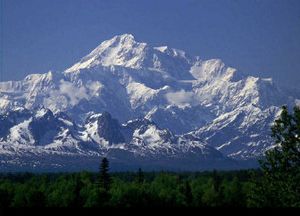Native Alaskans get clean sweep on Denali; hunters played major role in park
PUBLIC LANDS -- Mount McKinley, which reaches 20,320-feet above sea level, has a convoluted naming history that President Obama is clearing up this week. And with the publicity maybe more people will learn about the role sport hunters had in preserving the surrounding Alaska landscape and the wildlife within it.
Obama has announced he will rename North America's highest peak Denali, taking it back to its roots. Local Athabaskan Indians had reverently called the ice-covered mountain Denali, "The High One," as first recorded in 1794 by British explorer 'George' Vancouver.
Despite what Ohio lawmakers say, Denali, the name most climbers and natives have continued to use, seems much more appropriate than the moniker dropped on the mountain in 1896 by a prospector who wanted to promote an Ohio presidential candidate he favored. President William McKinley was elected the 25th president of the United States in 1897, but he had no significant association with Denali.
- Alaska newspaper Twitter feedback indicates that most residents, as well as the state's Republican congressional delegation, thought the renaming was over-due.
- Mount Rainier should be next up for renaming!
Mount McKinley National Park was designated after a campaign led by naturalist Charles Sheldon was supported by the Boone and Crockett Club and endorsed by club co-founder President Theodore Roosevelt. The area was important for wildlife such as grizzly bears, moose and caribou. But it was the distinctive white bighorns, the Dall sheep, that caught the hunters' attention.
Without protection, the wildlife and especially the Dall Sheep near Mount McKinley would be slaughtered by trophy hunters, Sheldon argued. The hunters, who prized Dall sheep for trophies, knew that limits and sanctuaries were critical in the bighorn's long-term survival.
After years of campaigning, on Feb. 26, 1917, Sheldon personally delivered the bill to President Wilson for signing.
According to National Parks: America's Best Idea by Ken Burns, Sheldon's only disappointment was that Congress, in creating Mount McKinley National Park, had ignored his pleas to return the mountain to its original name: Denali.
The Alaska National Interest Lands Conservation Act of 1980, a weeping monumental agreement throughout the state worked out by President Jimmy Carter, nearly tripled the size of Mount McKinley National Park. The act added 2.4 million acres to the park plus an additional 1.3 million acres in two adjacent national preserves. The name of the park was changed the Denali National Park and Preserve to reflect its deeper history.
But North America's highest peak continued to be officially named Mount McKinley.
Climbers focused on the prize of McKinley's summit early on, with the Wickersham party making an unsuccessful attempt in 1903.
The first ascent of the north summit was made by Sourdough Expedition prospectors in 1910, followed by the first ascent of the higher south summit by the son of a fur trapper in 1913.
McKinley continues to be a major international climbing attraction during a short spring window when mountain conditions are appropriate. Park records show that 1,204 climbers registered to attempt a McKinley ascent in 2014 and only 429 -- 36 percent -- reached the summit and returned safely.
Denali National Park is accessible by highway between Anchorage and Fairbanks. Once inside the park, the Denali Park Road is 92 miles long, and only the first 15 miles of it are paved. Summer travel beyond mile 15 is by shuttle or tour bus, or under human power.
The chances of seeing the spectacular view of North America's highest peak from Wonder Lake, near the end of the Denali Park Road, are slim in the unpredictable weather, but worth the chance. Now those signs visitors have read for decades will be changed to reflect the mountain's new name and long history.
Denali Park attracts about 400,000 visitors a year compared with about 3.5 million at Yellowstone National Park in the Lower 48.

